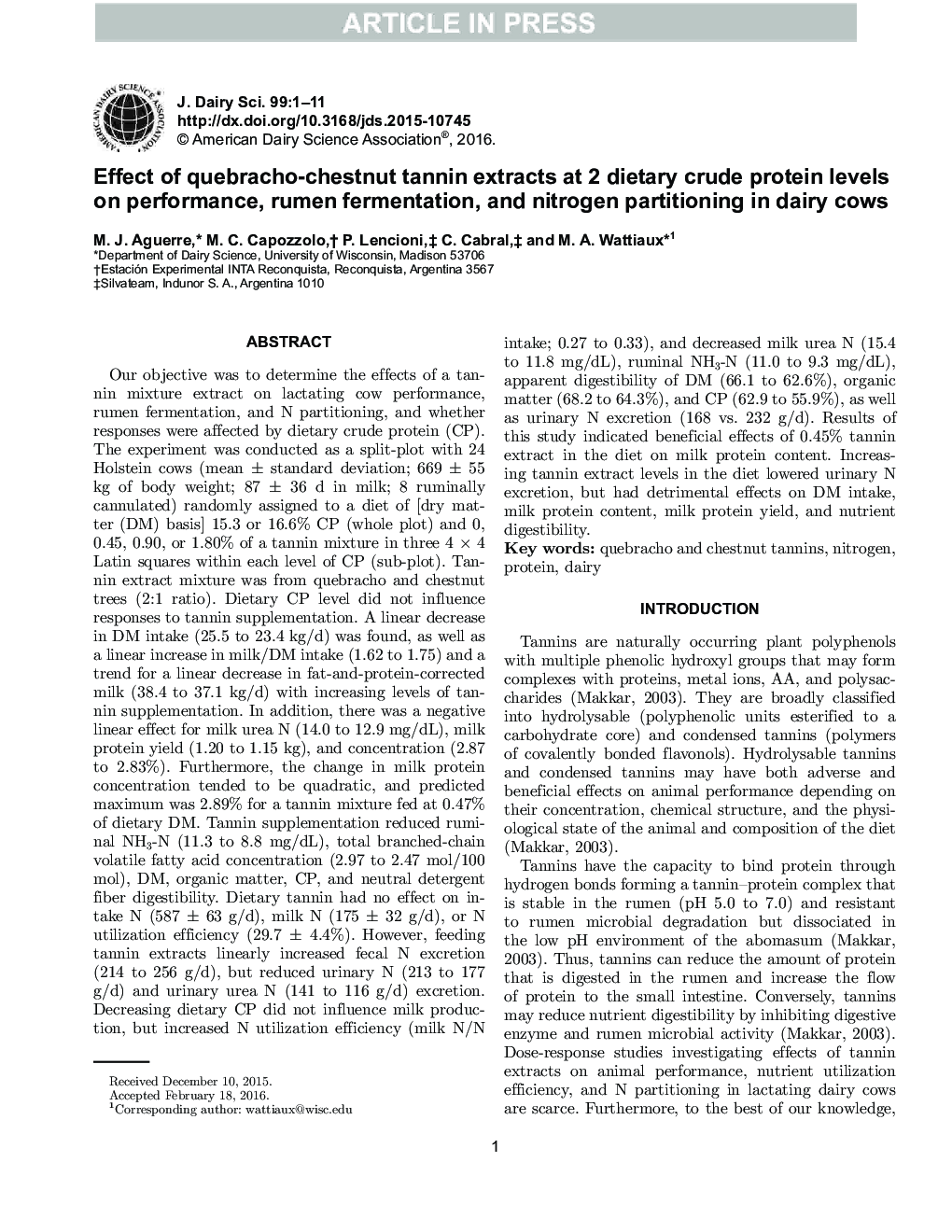| Article ID | Journal | Published Year | Pages | File Type |
|---|---|---|---|---|
| 10973311 | Journal of Dairy Science | 2016 | 11 Pages |
Abstract
Our objective was to determine the effects of a tannin mixture extract on lactating cow performance, rumen fermentation, and N partitioning, and whether responses were affected by dietary crude protein (CP). The experiment was conducted as a split-plot with 24 Holstein cows (mean ± standard deviation; 669 ± 55 kg of body weight; 87 ± 36 d in milk; 8 ruminally cannulated) randomly assigned to a diet of [dry matter (DM) basis] 15.3 or 16.6% CP (whole plot) and 0, 0.45, 0.90, or 1.80% of a tannin mixture in three 4 Ã 4 Latin squares within each level of CP (sub-plot). Tannin extract mixture was from quebracho and chestnut trees (2:1 ratio). Dietary CP level did not influence responses to tannin supplementation. A linear decrease in DM intake (25.5 to 23.4 kg/d) was found, as well as a linear increase in milk/DM intake (1.62 to 1.75) and a trend for a linear decrease in fat-and-protein-corrected milk (38.4 to 37.1 kg/d) with increasing levels of tannin supplementation. In addition, there was a negative linear effect for milk urea N (14.0 to 12.9 mg/dL), milk protein yield (1.20 to 1.15 kg), and concentration (2.87 to 2.83%). Furthermore, the change in milk protein concentration tended to be quadratic, and predicted maximum was 2.89% for a tannin mixture fed at 0.47% of dietary DM. Tannin supplementation reduced ruminal NH3-N (11.3 to 8.8 mg/dL), total branched-chain volatile fatty acid concentration (2.97 to 2.47 mol/100 mol), DM, organic matter, CP, and neutral detergent fiber digestibility. Dietary tannin had no effect on intake N (587 ± 63 g/d), milk N (175 ± 32 g/d), or N utilization efficiency (29.7 ± 4.4%). However, feeding tannin extracts linearly increased fecal N excretion (214 to 256 g/d), but reduced urinary N (213 to 177 g/d) and urinary urea N (141 to 116 g/d) excretion. Decreasing dietary CP did not influence milk production, but increased N utilization efficiency (milk N/N intake; 0.27 to 0.33), and decreased milk urea N (15.4 to 11.8 mg/dL), ruminal NH3-N (11.0 to 9.3 mg/dL), apparent digestibility of DM (66.1 to 62.6%), organic matter (68.2 to 64.3%), and CP (62.9 to 55.9%), as well as urinary N excretion (168 vs. 232 g/d). Results of this study indicated beneficial effects of 0.45% tannin extract in the diet on milk protein content. Increasing tannin extract levels in the diet lowered urinary N excretion, but had detrimental effects on DM intake, milk protein content, milk protein yield, and nutrient digestibility.
Related Topics
Life Sciences
Agricultural and Biological Sciences
Animal Science and Zoology
Authors
M.J. Aguerre, M.C. Capozzolo, P. Lencioni, C. Cabral, M.A. Wattiaux,
